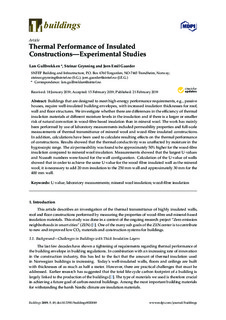| dc.contributor.author | Gullbrekken, Lars | |
| dc.contributor.author | Grynning, Steinar | |
| dc.contributor.author | Gaarder, Jørn Emil | |
| dc.date.accessioned | 2019-03-05T12:42:56Z | |
| dc.date.available | 2019-03-05T12:42:56Z | |
| dc.date.created | 2019-02-27T10:18:43Z | |
| dc.date.issued | 2019 | |
| dc.identifier.issn | 2075-5309 | |
| dc.identifier.uri | http://hdl.handle.net/11250/2588777 | |
| dc.description.abstract | Buildings that are designed to meet high-energy performance requirements, e.g., passive houses, require well-insulated building envelopes, with increased insulation thicknesses for roof, wall and floor structures. We investigate whether there are differences in the efficiency of thermal insulation materials at different moisture levels in the insulation and if there is a larger or smaller risk of natural convection in wood-fibre based insulation than in mineral wool. The work has mainly been performed by use of laboratory measurements included permeability properties and full-scale measurements of thermal transmittance of mineral wool and wood-fibre insulated constructions. In addition, calculations have been used to calculate resulting effects on the thermal performance of constructions. Results showed that the thermal conductivity was unaffected by moisture in the hygroscopic range. The air permeability was found to be approximately 50% higher for the wood-fibre insulation compared to mineral wool insulation. Measurements showed that the largest U-values and Nusselt numbers were found for the wall configuration. Calculation of the U-value of walls showed that in order to achieve the same U-value for the wood-fibre insulated wall as the mineral wool, it is necessary to add 20 mm insulation to the 250 mm wall and approximately 30 mm for the 400 mm wall. | nb_NO |
| dc.language.iso | eng | nb_NO |
| dc.publisher | MDPI | nb_NO |
| dc.rights | CC BY | * |
| dc.rights.uri | http://creativecommons.org/licenses/by-nc-nd/4.0/deed.no | * |
| dc.subject | U-value | nb_NO |
| dc.subject | Laboratory measurements | nb_NO |
| dc.subject | Mineral wool insulation | nb_NO |
| dc.subject | Wood-fibre insulation | nb_NO |
| dc.title | Thermal Performance of Insulated Constructions—Experimental Studies | nb_NO |
| dc.type | Journal article | nb_NO |
| dc.type | Peer reviewed | nb_NO |
| dc.description.version | publishedVersion | nb_NO |
| dc.rights.holder | © 2019 by the authors. Licensee MDPI, Basel, Switzerland. This article is an open access article distributed under the terms and conditions of the Creative Commons Attribution (CC BY) license (http://creativecommons.org/licenses/by/4.0/). | nb_NO |
| dc.source.volume | 9 | nb_NO |
| dc.source.journal | Buildings | nb_NO |
| dc.source.issue | 2 | nb_NO |
| dc.identifier.doi | 10.3390/buildings9020049 | |
| dc.identifier.cristin | 1680973 | |
| dc.relation.project | Norges forskningsråd: 257660 | nb_NO |
| cristin.unitcode | 7401,30,40,0 | |
| cristin.unitname | Arkitektur, byggematerialer og konstruksjoner | |
| cristin.ispublished | true | |
| cristin.fulltext | original | |
| cristin.qualitycode | 1 | |

